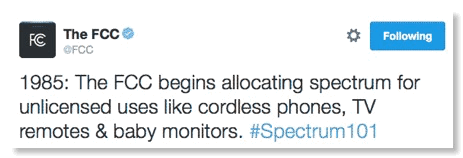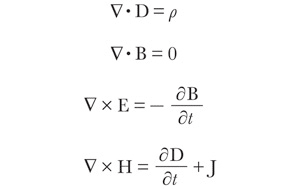@FCC Makes Unforced Error on History of Unlicensed

At 12:06 PM on April 1, 2016 the official FCC Twitter account, @FCC, sent out the above tweet as part of "Spectrum101: Great Moments in Spectrum History". It has now been deleted, possibly because I responded to this tweet with the statement that while the unlicensed ISM band that is home to Wi-Fi and Bluetooth (and many other devices) began in May 1985, unlicensed spectrum has been around since 1938 although it is not explicitly authorized in the Communications Act of 1934. Hopefully, some readers here are old enough to remember that cordless phones predate 1985. (If you can't remember this, ask your parents.)
The video below shows the FCC's May 1985 decision and may explain why I remember it so clearly:
Former FCC staffer Kenneth Carter explained the actual history of unlicensed in a 2009 paper titled "Unlicensed to kill: a brief history of the Part 15 rules". Ken wrote:
In 1938, shortly after its founding, the FCC first permitted unlicensed devices to be sold and operated without a license. The Part 15 rules stem from what is possibly an oversight offundamental physical phenomenon by the Communications Act of 1934. Congress had intended to treat the regulation of spectrum in the way in which we traditionally think of it. Namely, the FCC was to award rights through licensing discrete individual entities, including such as radio broadcasters, the military, and the alike. This, however, failed to recognize two facts. First, that nearly all devices that employ electricity leak or reradiate electromagnetic energy, albeit at very low power levels. Second, also at this time, radio device manufacturers started introduce short range, low duty cycle communication devices which operated employing low levels of energy over very short distances[8]. As a result, the FCC set about to promulgate rules to manage such devices based on the jurisprudence that if RF emissions that were sufficiently weak and short ranged so as to not be considered measurable, they would, therefore, not rise to the level of harmful interference. This was explained by then-FCC Chief Engineer, Ewell Jett in 1938:
"What we are concerned with immediately is the problem of interference. If certain low power devices can be used without interfering with radio communications, there would appear to be no engineering reason for suppressing their use. (Footnotes omitted)
What is the difference between 1938 style unlicensed spectrum and post 1985 style? The original unlicensed rules allowed only specific functionality in a specific band requested by a petitioner. This band could be used by cordless phones, this for garage door openers. Always with very low power. Have a new possible use? File a petition and wait!
The Docket 81-413 regime adopted in 1985 set forth some technical requirements and allowed much higher power. It did not restrict the type of use. Thus while the rulemaking never mentioned radio LANs, when they became important in the late 1980s the RLAN proponents used the Docket 81-413 unlicensed regime to get access to the ISM bands quickly without nonroutine FCC action. True "permissionless innovation" before the term was invented!
Another garble in the this short length (and short lived tweet) is the use of "allocating" as the 5th word. All real spectrum wonks know that unlicensed is not an allocation, rather it is a permitted secondary use on an NIB (noninterference basis). Why there were so many garbles in such a short tweet is puzzling and raises questions of FCC as an "expert agency in spectrum".
Or maybe we should have read the date more carefully? However the other "#Spectrum101" tweets the same day seemed correct.
Our fellow bloggers at CommLawBlog on the same day as this tweet had an April Fools post entitled "Looking for Improved Public Image, FCC Reorganizes Office of Media Relations". After reading both the tweet and the CommLawBlog post, it is hard to tell which is real!
Happy 150th Birthday Maxwell's Equations!

As shown above, December 8 is the 150th anniversary of James Clerk Maxwell’s presentation on electromagnetic theory to the Royal Society in London. While the 4 equation for the interaction of electric and magnetic fields that we techies know well were not written in the current form for another 20 years, the basic theory was all there in complex form involving 20 equations. (Oliver Heaviside, who is mentioned parenthetically in a song in the musical Cats, was later responsible for the 4 equation version and the modern vector notation.)
Maxwell showed how previous electrical and magnetic observations were all consistent and related to each other and also predicted electromagnetic waves, e.g. radio and light. Maxwell died in 1879. In 1886 Heinrich Hertz of Technische Hochschule (now the Karlsruhe Institute of Technology) in Karlsruhe, Germany demonstrated that electromagnetic waves/radio waves actually exist.
The current issue of IEEE Spectrum magazine has a nice article for general audiences on how this all came about and its significance. Below are the 4 equations, in differential form - physicists often prefer the integral form - along with Spectrum’s brief summary.

Today, the relationship between electricity and magnetism, along with the wave nature of light and electromagnetic radiation in general, is encoded in the four “Maxwell’s equations” shown above. The equations can be written in different ways. Here, J is the current density. E and B are the electric and magnetic fields, respectively. And there are two other fields, the displacement field D and the magnetic field H. These fields are related to E and B by constants that reflect the nature of the medium that the fields pass through (the values of these constants in vacuum can be combined to give the speed of light). The displacement field D was one of Maxwell’s key contributions, and the last equation describes how both current and changing electric fields can give rise to magnetic fields. The symbols at the beginning of each equation are differential operators. These compactly encode calculus that involves vectors, quantities that have a directionality and thus x, y, and z components. Maxwell’s original formulation of his electromagnetic theory contained 20 equation



![Validate my RSS feed [Valid RSS]](valid-rss-rogers.png)

